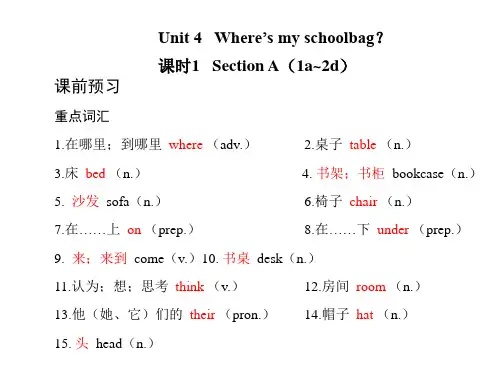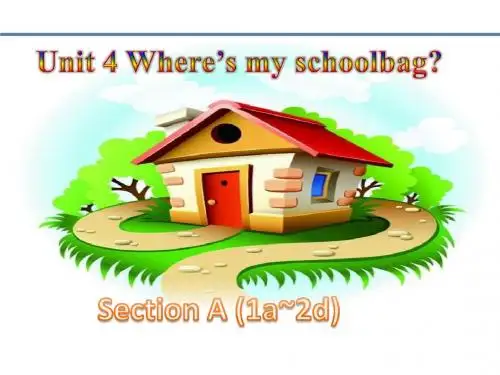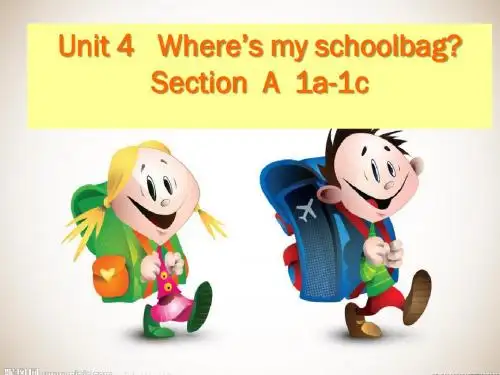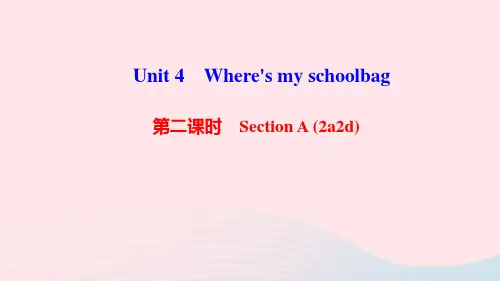新目标英语七年级上册unit4Where_is_my_schoolbag课件
- 格式:ppt
- 大小:6.15 MB
- 文档页数:83
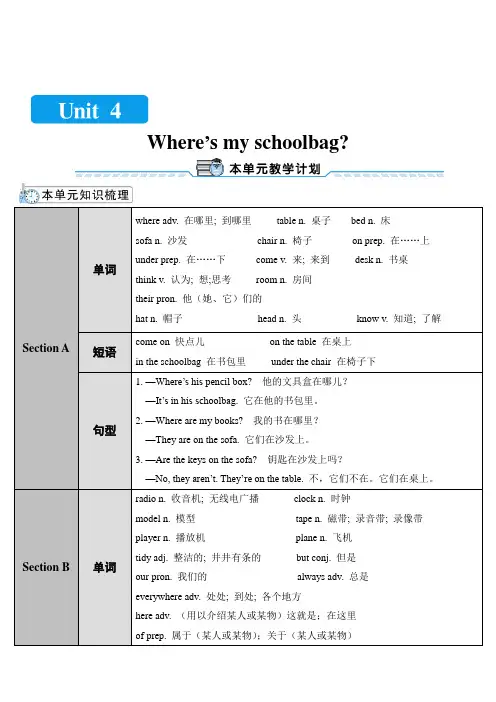
Where’s my schoolbag?Section A 单词where adv. 在哪里; 到哪里table n. 桌子bed n. 床sofa n. 沙发chair n. 椅子on prep. 在……上under prep. 在……下come v. 来; 来到desk n. 书桌think v. 认为; 想;思考room n. 房间their pron. 他(她、它)们的hat n. 帽子head n. 头know v. 知道; 了解短语come on 快点儿on the table 在桌上in the schoolbag 在书包里under the chair 在椅子下句型1. —Where’s his pencil box? 他的文具盒在哪儿?—It’s in his schoolbag. 它在他的书包里。
2. —Where are my books? 我的书在哪里?—They are on the sofa. 它们在沙发上。
3. —Are the keys on the sofa? 钥匙在沙发上吗?—No, they aren’t. They’re on the table. 不,它们不在。
它们在桌上。
Section B 单词radio n. 收音机; 无线电广播clock n. 时钟model n. 模型tape n. 磁带; 录音带; 录像带player n. 播放机plane n. 飞机tidy adj. 整洁的; 井井有条的but conj. 但是our pron. 我们的always adv. 总是everywhere adv. 处处; 到处; 各个地方here adv. (用以介绍某人或某物)这就是;在这里of prep. 属于(某人或某物);关于(某人或某物)短语model plane 飞机模型be tidy 保持整洁tape player 磁带播放机in the bookcase在书柜里句型1. Gina’s books are everywhere. 吉娜的书到处都是。
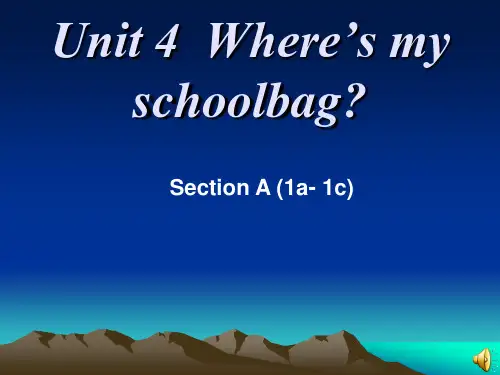
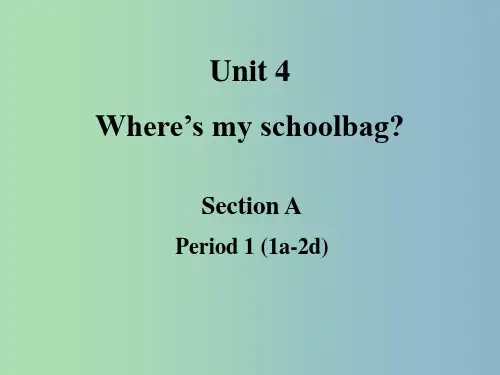
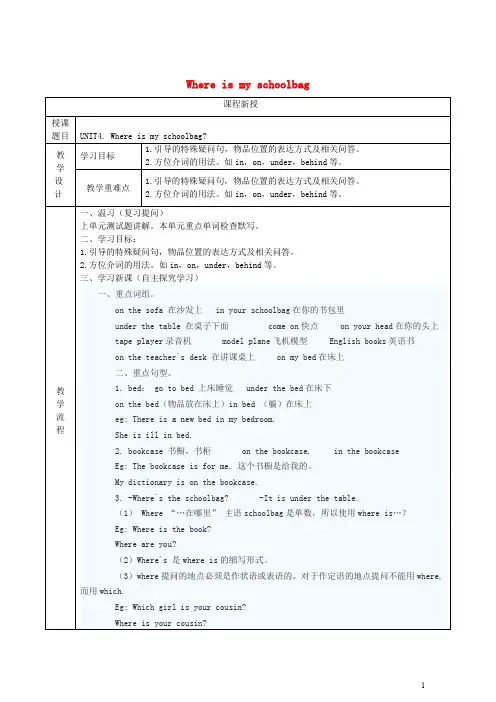
Where is my schoolbag(4)under在……下Eg: Your baseball is under the bed.The girl under the tree is my sister.(5)table桌子 Eg: Where is the table?有关短语: under the table在桌子底下 on the table在桌子上at table在吃饭 at the table在桌子旁边Eg: She is at table.她在吃饭。
My dog is at the table. 我的狗在桌子旁边。
4. Come on! “走吧,快点,跟着来,进展”Eg: Come on! We don`t have much time.You`d better go now, and I will come on later.How are things coming on?5. I think it is in your grandparents` room.(1)这是一个含有宾语从句的复合句。
主句是I think,从句是it`s in your grandparents` room从句省略了引导词that。
Eg: I think English is very important.用法点拨:在含有I/We think…引导的宾语从句中,如果宾语从句要表达(2)否定的意义,那么其否定形式转移到动词think上,这叫否定转移。
Eg: I don`t think you are right.We don`t think he is poor.(3)room房间 eg: She lives in Room 234.Room还有空间、空地的意思,此时是不可数名词。
Make room for sb“为某人腾出地方” eg: Please make room for me知识点解析1.at the table 在桌子旁 at table 在吃饭2.take 带走。
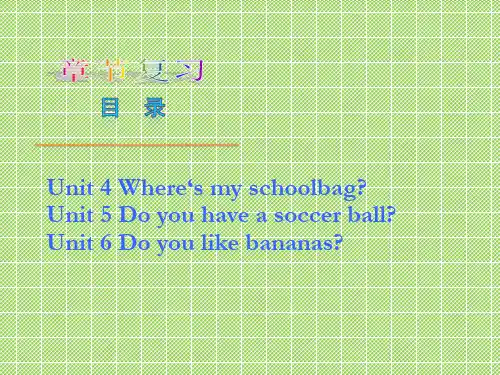

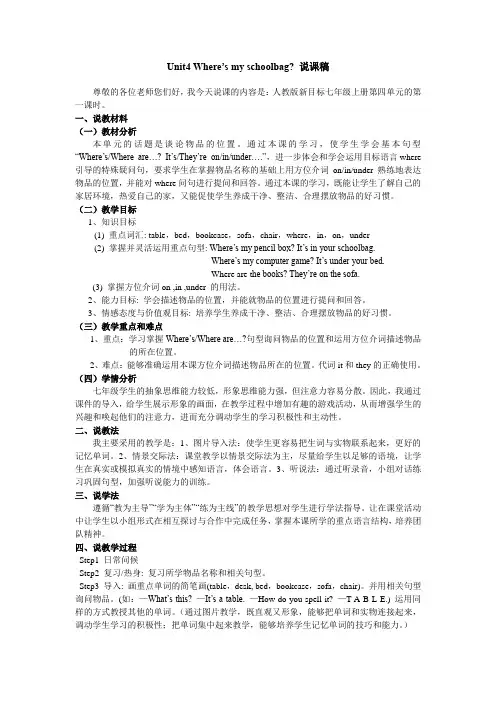
Unit4 Where’s my schoolbag? 说课稿尊敬的各位老师您们好,我今天说课的内容是:人教版新目标七年级上册第四单元的第一课时。
一、说教材料(一)教材分析本单元的话题是谈论物品的位置。
通过本课的学习,使学生学会基本句型“Where’s/Where are…? It’s/They’re on/in/under….”,进一步体会和学会运用目标语言where 引导的特殊疑问句,要求学生在掌握物品名称的基础上用方位介词on/in/under熟练地表达物品的位置,并能对where问句进行提问和回答。
通过本课的学习,既能让学生了解自己的家居环境,热爱自己的家,又能促使学生养成干净、整洁、合理摆放物品的好习惯。
(二)教学目标1、知识目标(1) 重点词汇: table,bed,bookcase,sofa,chair,where,in,on,under(2) 掌握并灵活运用重点句型: Where’s my pencil box? It’s in your schoolbag.Where’s my computer game? It’s under your bed.Where are t he books? They’re on the sofa.(3) 掌握方位介词on ,in ,under 的用法。
2、能力目标: 学会描述物品的位置,并能就物品的位置进行提问和回答。
3、情感态度与价值观目标: 培养学生养成干净、整洁、合理摆放物品的好习惯。
(三)教学重点和难点1、重点:学习掌握Where’s/Where are…?句型询问物品的位置和运用方位介词描述物品的所在位置。
2、难点:能够准确运用本课方位介词描述物品所在的位置。
代词it和they的正确使用。
(四)学情分析七年级学生的抽象思维能力较低,形象思维能力强,但注意力容易分散。
因此,我通过课件的导入,给学生展示形象的画面,在教学过程中增加有趣的游戏活动,从而增强学生的兴趣和唤起他们的注意力,进而充分调动学生的学习积极性和主动性。
